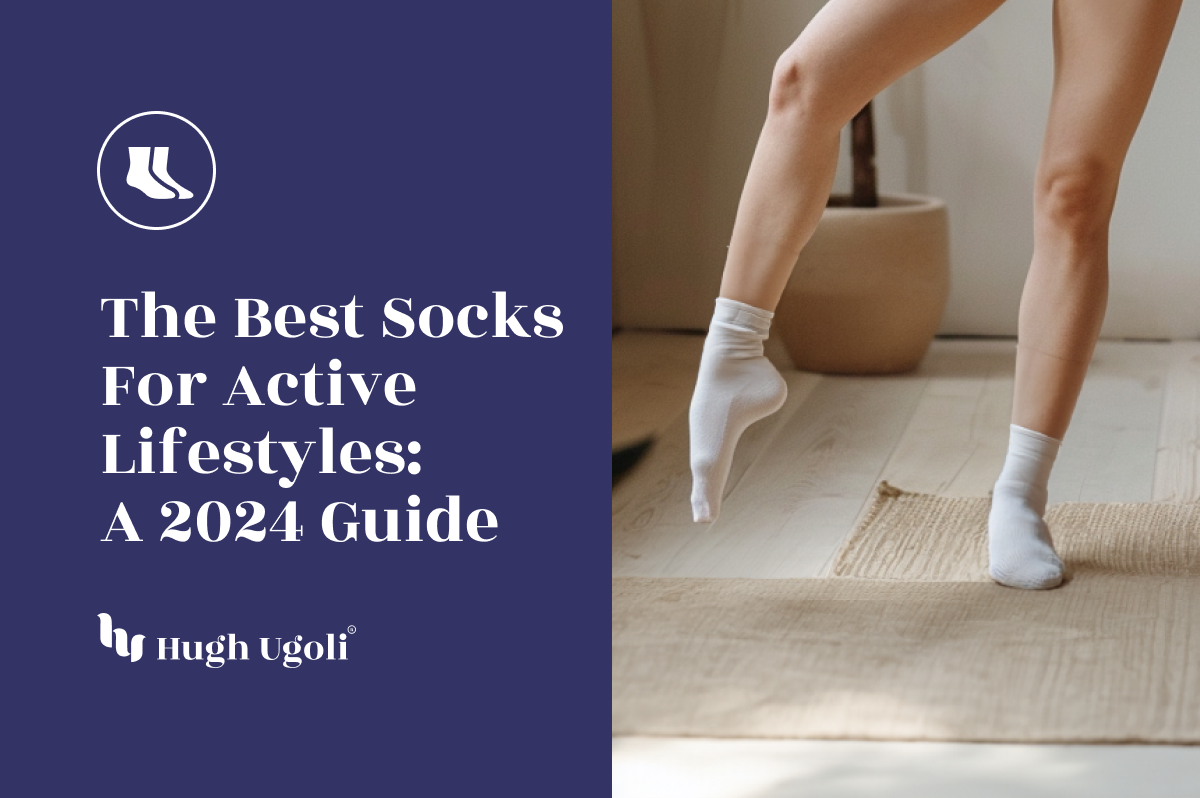In 2024, active lifestyles demand socks that provide comfort, durability, and advanced moisture-wicking properties. This guide explores the best socks for various activities, ensuring your feet stay dry and comfortable throughout the day. Whether you prefer cotton socks, merino wool, or synthetic blends, there's a perfect pair of socks for every active individual.
Why Moisture-Wicking Socks Matter
Moisture-wicking socks are essential for anyone leading an active lifestyle. They help keep your feet dry by drawing moisture away from the skin, reducing the risk of blisters and infections.
Benefits of Moisture-Wicking Socks
- Keeps Feet Dry: Advanced fibers wick sweat away, ensuring your feet remain dry.
- Reduces Odor: By managing moisture, these socks help minimize odors caused by bacteria.
- Prevents Blisters: Dry feet are less prone to blisters and discomfort during activities.

Top Sock Materials for Active Lifestyles
Choosing the right material is crucial for comfort and performance. Here are some top materials used in active lifestyle socks:
Cotton Socks
Cotton socks are popular for their natural softness and breathability. They are ideal for everyday wear but may not be the best for intense activities due to their limited moisture-wicking capabilities.
- Best For: Day wear and casual activities.
- Example Product: Men’s Cotton Dress Seamless Toe Business Crew Socks.
Merino Wool
Merino wool is a top choice for active individuals. It's naturally moisture-wicking, temperature-regulating, and odor-resistant, making it perfect for both warm and cold weather.
- Best For: Hiking, running, and outdoor activities.
- Example Product: Warm Wool Women's Crew Socks.
Choosing the Right Sock Length
The length of your socks can impact both comfort and style. Here are some popular lengths and their benefits:
Ankle Socks
Ankle socks are perfect for low-cut shoes and warmer weather. They provide minimal coverage, ensuring your feet stay cool and comfortable.
- Best For: Running, gym workouts, and casual wear.
- Example Product: Men's Diabetic Ankle Thin Cotton Socks.
Crew Socks
Crew socks offer more coverage and are versatile for both athletic and casual wear. They typically reach mid-calf, providing added protection and support.
- Best For: Hiking, outdoor sports, and everyday use.
- Example Product: Women’s Bamboo Dress Crew Socks.
Specialty Socks for Specific Activities
Different activities require specific sock features to maximize comfort and performance. Here are some recommendations:
Hiking Socks
Hiking socks need to be durable, moisture-wicking, and cushioned to provide support during long treks. Merino wool and synthetic blends are excellent choices.
- Best For: Hiking and outdoor adventures.
- Example Product: Bamboo Dress Funky Socks for Men's
Dress Socks
For a professional look, dress socks should combine style with comfort. Opt for socks that offer moisture-wicking properties and a snug fit without being too tight.
- Best For: Business and formal occasions.
- Example Product: Fancy Cotton Dress Crew Socks For Mens With Gift Box.
Caring for Your Active Socks
Proper care extends the life of your socks and maintains their performance features. Here are some tips:
Washing
- Machine Wash: Use a gentle cycle with cold water to prevent damage.
- Avoid Bleach: Bleach can weaken fibers and reduce moisture-wicking capabilities.
Drying
- Air Dry: Lay socks flat to dry to maintain their shape and elasticity.
- Avoid Heat: High heat can shrink and damage the fibers.
Benefits of Wool Socks for Active Lifestyles
Wool socks, especially those made from merino wool, are a favorite among active individuals. They offer several advantages that make them ideal for various activities.
Moisture Management
Wool is a natural moisture-wicking material, which means it helps keep your feet dry by drawing sweat away from the skin.
- Prevents Blisters: Dry feet are less likely to develop blisters during intense activities.
- Reduces Odor: Wool's natural properties help reduce foot odor, keeping your feet fresh.
Temperature Regulation
Wool is excellent at regulating temperature, making it suitable for both hot and cold conditions.
- Keeps Feet Warm: Wool socks provide insulation during cold weather, keeping your feet warm.
- Cool in Summer: In warmer conditions, wool helps to wick moisture away, keeping your feet cool.
The Importance of Proper Sock Fit
Wearing socks that fit properly is essential for both comfort and performance. Ill-fitting socks can cause discomfort and even lead to injuries.
Finding the Perfect Fit
- Size Matters: Choose socks that match your shoe size to ensure a snug fit without being too tight.
- Avoid Bunching: Properly fitting socks will stay in place and prevent bunching, which can cause blisters.
The Role of Compression Socks
Compression socks are designed to improve blood circulation and reduce muscle fatigue, making them beneficial for various activities.
Benefits of Compression Socks
- Enhanced Circulation: Compression socks apply gentle pressure to the legs, promoting better blood flow.
- Reduced Swelling: They help reduce swelling, particularly during long periods of standing or sitting.
Sustainable Sock Choices
As sustainability becomes increasingly important, many brands are focusing on eco-friendly sock options. These socks are made from sustainable materials and produced using environmentally friendly methods.
Eco-Friendly Materials
- Bamboo: Bamboo socks are soft, moisture-wicking, and biodegradable.
- Recycled Materials: Some socks are made from recycled polyester, reducing waste and conserving resources.
Socks for Different Weather Conditions
Choosing the right socks for different weather conditions ensures comfort and protection for your feet.
Winter Socks
- Insulation: Look for wool socks or socks with added insulation to keep your feet warm.
- Moisture-Wicking: Ensure they have moisture-wicking properties to keep your feet dry.
Summer Socks
- Breathability: Lightweight and breathable materials like cotton are ideal for hot weather.
- Low-Cut: Ankle socks are great for summer as they provide less coverage and allow for better airflow.
Conclusion
Choosing the right socks for an active lifestyle involves considering materials, length, and specific activity needs. With the right pair, you can ensure comfort, performance, and durability. Explore more about selecting the best socks for different occasions by visiting our Guide to Buying Eco-Friendly Socks: What to Look for.
















